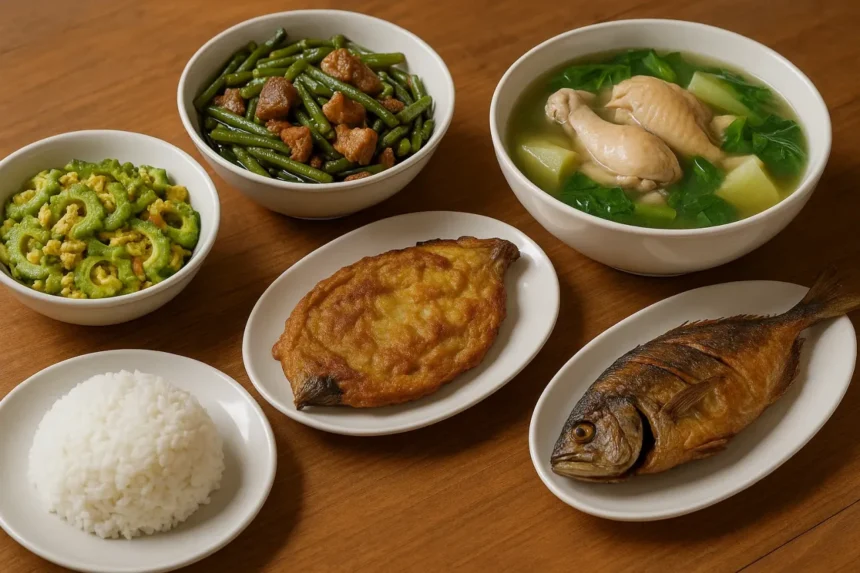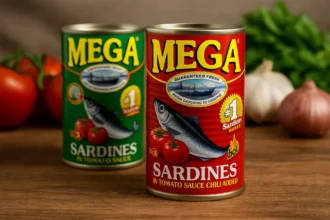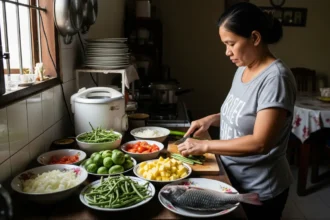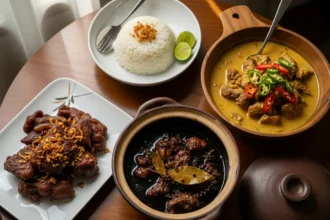Feeding a Filipino family on a tight budget is a challenge that many parents face daily. With the rising prices of groceries, even simple staples like rice, gulay, and meat can quickly add up. Para sa mga nanay at tatay, it often feels like a balancing act – how do you serve masarap at busog ulam without overspending?
The truth is, you don’t always need fancy ingredients or big cuts of meat to prepare delicious meals. Filipino cooking has always been about creativity, resourcefulness, and making the most out of what you have. From stretching one bangus into two different dishes, to turning gulay and itlog into hearty meals, tipid recipes are part of our everyday survival.
This list brings you 20 easy ulam ideas under ₱150 – simple, hearty, and distinctly Filipino dishes that prove tipid meals can still taste like home. Each one is affordable, easy to cook, and guaranteed to keep the whole family happy at mealtime. Whether you’re feeding a barkada of kids after school or making a quick dinner on a weekday, these dishes are here to help you save without sacrificing flavor.

🐟 Classic Fish Dishes
Fish remains one of the go-to proteins for Filipino families because it’s versatile, nutritious, and relatively affordable. Wet markets offer small but filling varieties like galunggong, tilapia, and bangus, which can easily be stretched to feed a family of four to five. When cooked in classic Pinoy ways, they don’t just fill the stomach – they bring back the comforting flavors of home.
- Pritong Galunggong – The simplest but most beloved tipid ulam. Just season, fry, and serve with toyo’t calamansi or suka. Best eaten with plenty of rice and kamatis on the side. For extra budget stretch, some families pair it with munggo or ginisang gulay.
- Tilapia Escabeche – A fried tilapia topped with a sweet and sour sauce made of carrots, bell peppers, and onions. A great way to dress up a humble fish into something that feels pang-handaan, without spending beyond ₱150.
- Ginataang Tilapia – Tilapia simmered in gata (coconut milk) with malunggay or pechay. Nutritious, creamy, and filling – perfect for growing kids. Since gulay is included in the dish, it can stand alone as a complete meal with rice.
- Paksiw na Isda – Galunggong or bangus cooked in vinegar, garlic, and ginger. This dish tastes even better the next day when the flavors have fully absorbed into the fish. Pair it with fried rice in the morning and you’ve got another meal without extra gastos.
💡 Budget Tip: Buying fish from the palengke early in the morning usually gives you the freshest catch at the lowest price. For families, galunggong at around ₱120–₱140 per kilo can already make 2–3 meals when cooked differently.
All of these classic Filipino fish dishes cost less than ₱150 depending on market prices, especially if paired with gulay side dishes or eaten with plenty of rice. Simple, hearty, and sulit – exactly what Filipino families need on a tight budget.

🥦 Vegetable-Based Ulam
Vegetables are the backbone of tipid meals. Nutritious and cheap, they stretch easily when combined with rice or small amounts of meat. Filipinos have perfected the art of making gulay dishes delicious and satisfying.
- Ginisang Ampalaya – Bitter melon sautéed with egg, tomatoes, and onions. Soaking the slices in salted water before cooking helps reduce the bitterness, making it more kid-friendly. Some families add dried shrimp or a bit of ground pork if the budget allows, but even plain with eggs, it’s already a hearty and healthy ulam.
- Adobong Sitaw – String beans cooked adobo-style with soy sauce, vinegar, and garlic. This dish is flavorful on its own but can be stretched further with small pieces of pork, tofu, or even leftover fried fish. A single bundle of sitaw from the palengke is cheap yet enough to feed the whole family with rice.
- Laing – Gabi leaves simmered in coconut milk and chilies for a creamy, spicy kick. Some add dried fish or smoked tinapa to give it more depth of flavor. Best paired with plain rice, laing is so rich and filling that you don’t need any other ulam on the table.
- Pinakbet – A mix of ampalaya, okra, squash, and eggplant flavored with bagoong. The combination of gulay makes every bite flavorful and nutritious, while the bagoong ties everything together with its savory taste. Families often cook a big pot of pinakbet to stretch for multiple meals.
These dishes are filling, healthy, and typically cost under ₱100, making them perfect for everyday home cooking.
🍳 Egg and Tofu Specials
Eggs and tofu are budget-friendly sources of protein that are quick to prepare. They’re lifesavers for families looking for fast and cheap ulam options that don’t compromise on taste.
- Tortang Talong – Grilled eggplant dipped in beaten egg and fried until golden brown. This dish is smoky, hearty, and perfect with ketchup or sawsawan on the side. Some stretch it further by adding ground pork or tinapa flakes, but even the plain version is already satisfying with rice.
- Tokwa’t Baboy (Budget Version) – A classic pulutan turned everyday ulam, this version uses more tokwa (tofu) and just a small amount of pork for flavor. The cubes are seasoned with soy sauce, vinegar, onions, and chili for that tangy kick. Filling, high in protein, and affordable.
- Fried Tokwa with Garlic Sauce – Crispy tofu cubes fried until crunchy outside but soft inside, then drizzled with garlic and vinegar sauce. Simple, quick to cook, and pairs well with rice or even as an extra side dish to stretch another ulam.
- Ginisang Itlog at Kamatis – Scrambled eggs with sautéed tomatoes, a timeless Filipino favorite that works for both breakfast and ulam. It’s flavorful, comforting, and can be cooked in under 10 minutes. Some also add sibuyas or a dash of patis for extra depth.
Each of these can be cooked for well below ₱150, making them ideal for tipid days while still keeping the family busog and happy.
🍗 Chicken Dishes on a Budget
Chicken is a Filipino household staple, but with careful cooking, even one small cut can feed several people. Buying native-style cuts in wet markets often helps keep costs down.
- Tinolang Manok (Budget Style) – Small cuts of chicken simmered with ginger, sayote, and malunggay. Unlike the usual version with papaya, sayote is cheaper and just as filling. The hot broth is comforting and nutritious, making it a go-to dish for rainy days. A single quarter of chicken can already flavor a whole pot, especially when stretched with plenty of gulay.
- Adobong Manok sa Patis – A clever twist on adobo that uses patis (fish sauce), garlic, and pepper instead of pricier soy sauce. The result is a savory, umami-packed dish that goes perfectly with rice. It’s one of those recipes that proves simple pantry staples can turn chicken into a satisfying everyday ulam.
- Chicken Afritada (Simplified) – A tomato-based chicken stew cooked with potatoes and carrots, but done in a tipid way by scaling down the meat portion and bulking it up with vegetables. The sauce is rich and flavorful, perfect for soaking into rice. It’s a budget-friendly version of a dish often served in fiestas, making it feel special without spending much.
While chicken prices vary, portioning wisely and combining with vegetables makes these meals stretchable and affordable, keeping the whole family busog even on a budget.
🐖 Pork Ulam Ideas
Though pork is pricier, small portions used wisely can still fit a ₱150 budget. Filipinos are known for making the most out of little pork cuts by mixing them with vegetables or sauces that extend their flavor.
- Pork Giniling – Ground pork sautéed with carrots, potatoes, and green peas, then simmered in tomato sauce or fresh tomatoes. It’s a colorful, hearty dish that stretches a small amount of meat to feed a whole family. Leftovers can even be repurposed into torta or as bread filling, making it a versatile and budget-friendly ulam.
- Adobong Baboy (Budget Cut Version) – Instead of premium cuts, families often use liempo trimmings, ribs, or even fatty cuts that are cheaper in the wet market. Cooked with vinegar, soy sauce (or patis for a cheaper twist), and lots of garlic, it still delivers the full adobo flavor. Rice becomes irresistible with the sauce, which helps stretch the meal further.
- Pork Nilaga (Simplified) – A warm sabaw-based dish made by boiling small pork cuts with cabbage, potatoes, and pechay. Even if the pork portion is small, the broth and gulay make the dish hearty and filling. Perfect for stretching one meal into two sittings, especially during rainy days when sabaw is most comforting.
Limiting the pork but maximizing sabaw or gulay makes these options still affordable for families, proving that even pricier meats can fit into tipid ulam days.
🦐 Seafood and Other Pinoy Favorites
Seafood, when bought fresh and in-season, can be surprisingly affordable. They add variety to the weekly ulam cycle and make meals feel more festive without overspending.
- Ginataang Hipon (Budget Serving) – Shrimps cooked in creamy coconut milk, often paired with malunggay or kalabasa to stretch the dish further. Buying a small amount of hipon from the palengke and mixing it with gulay keeps the cost low while still delivering a rich, flavorful ulam that feels indulgent.
- Tuyo with Tomatoes and Egg – The ultimate tipid ulam that never goes out of style. Salty tuyo balanced with fresh tomatoes and scrambled egg makes for a simple yet satisfying meal. Paired with lots of rice and maybe some suka on the side, it’s one of those dishes that can feed the family without going over ₱150.
These dishes prove that even seafood and classic Pinoy favorites can be enjoyed by families on a tight budget, as long as portions are smart and gulay is used to extend the meals.
💡 Tips to Maximize Your ₱150 Budget
Shop in wet markets (palengke) – Prices in the palengke are often cheaper than in supermarkets, and you also get fresher produce, fish, and meat. Many vendors even give a little “pang-ulam” extra when you’re a suki.
- Buy gulay in-season – Seasonal vegetables cost less, are more abundant, and taste better. For example, kalabasa and sitaw are cheaper during harvest season, making it the perfect time to cook pinakbet or ginataang gulay.
- Stretch proteins with sabaw – Turning small amounts of chicken, pork, or fish into a sabaw-based dish like tinola, nilaga, or sinigang makes the meal more filling. A pot of broth shared with rice can go a long way in feeding the whole family.
- Cook big, store small – Prepare bigger portions when cooking tipid meals, then divide into smaller containers. Leftovers can be reheated for merienda, baon, or breakfast the next day, saving both money and effort.
- Use condiments smartly – Simple condiments like patis, suka, bagoong, or calamansi can transform a plain dish into something masarap. They add flavor without the need for expensive ingredients.
A little creativity and resourcefulness go a long way in making ₱150 meals not just budget-friendly, but also delicious, satisfying, and truly Filipino.
❓ Frequently Asked Questions (FAQ)
Q1: Can these ulam ideas really feed a family of 4–5 under ₱150?
Yes, if ingredients are bought fresh in wet markets and meals are portioned wisely. Pairing gulay with rice helps make servings more filling while keeping costs down.
Q2: How do I keep meals affordable with rising prices?
The key is seasonal buying and bulk cooking. Stick to vegetables in-season, buy fish in wet markets, and avoid heavily processed ingredients.
Q3: Are these meals healthy enough for kids?
Yes, many of these dishes are nutrient-rich, especially those with vegetables and fish. Balance them with fruits and occasional higher-protein meals to cover nutritional needs.
Q4: Can I replace pork or chicken with cheaper protein?
Definitely. Eggs, tofu, and dried fish are excellent alternatives. They are not only budget-friendly but also versatile in Filipino cooking.
Q5: Which ulam is the cheapest to prepare?
Dishes like ginisang itlog at kamatis, tuyo with egg, and ginisang gulay are among the cheapest, often costing under ₱100 total.
Q6: How often should I include meat in a tipid weekly menu?
You can aim for 2–3 meat-based dishes per week and fill the rest with vegetables, tofu, eggs, and fish. This balances cost and nutrition.
Q7: Are these recipes time-consuming?
Most are quick and simple, usually taking under 30 minutes. They’re perfect for busy parents who want affordable but tasty meals.
Q8: Can I cook these dishes ahead of time?
Yes. Many ulam like adobo, giniling, and paksiw taste better the next day. Cooking bigger portions and storing leftovers saves both time and money.
Q9: How can I make ₱150 meals taste special?
Experiment with spices, add a touch of gata, or serve with sawsawan dips. Even affordable dishes feel special when prepared with variety and love.
Q10: Where can I find full recipes for these dishes?
Most of these ulam ideas have step-by-step recipes available from Filipino food blogs, DOH nutrition resources, and community cooking groups online.
✨ Final Reflection: Creativity at the Filipino Dining Table
The truth is, budget cooking in the Philippines has always been about more than just saving money. It reflects Filipino resilience, ingenuity, and the deep cultural importance of sharing meals together. Even with only ₱150, families can create hearty dishes that not only fill the stomach but also strengthen family bonds.
These 20 affordable ulam ideas show that eating well doesn’t have to mean spending big. From humble gulay dishes to reimagined classics like adobo and tinola, they remind us that Pinoy cooking thrives on resourcefulness. In fact, some of the most comforting meals are those born out of necessity and simplicity.
Still, it’s important to see beyond cost. A truly satisfying family meal balances affordability, nutrition, and love in preparation. By making smart shopping choices, using in-season produce, and embracing traditional cooking methods, Filipinos can continue to stretch the budget without sacrificing health or taste.
At the heart of it all is the Filipino dining table – a place where joy, stories, and laughter are shared, no matter how modest the ulam may be. For parents and homemakers, mastering budget meals is more than a kitchen challenge. It’s a way of ensuring dignity, health, and happiness for the entire family, one plate at a time.
🍲 References
-
Panlasang Pinoy – Easy Filipino Recipes & Ulam Ideas
-
TheAsianParent PH – 30 Budget-Friendly Ulam Ideas
-
Maggi PH – 7 Diskarte Dishes Under ₱100
-
Recepedia PH – 40 Quick, Easy Ulam for Lunch
-
Youtube Simpol PH – Budget Filipino Recipes w/ Chef Tatung
-
Facebook #MsQKusina – Tipid Ulam Ideas Community Post
-
ThePeachKitchen – Best Ulam Ideas for the Whole Week
-
Grace Banal RD – Meal Plans & Tips for Busy Pinoys










